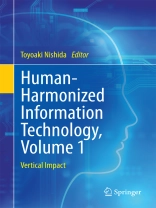Going from the philosophy and concepts to the implementation and user study, this book presents an excellent overview of Japan’s contemporary technical challenges in the field of human–computer interaction. The next information era will be one in which information is used to cultivate human and social potential. Driven by this vision, the outcomes provided in this work were accomplished as challenges to establish basic technologies for achieving harmony between human beings and the information environment by integrating element technologies including real-space communication, human interfaces, and media processing. Ranging from the neuro-cognitive level to the field trial, the research activities integrated novel perceptual technologies that even exceed human ability to sense, capture, and affect the real world.
This book grew out of one of the CREST research areas funded by the Japan Science and Technology Agency. The theme of the project is “the creation of human-harmonized information technology for convivial society”, where 17 research teams aimed at a common goal. The project promotes a trans-disciplinary approach featuring (1) recognition and comprehension of human behaviors and real-space contexts by utilizing sensor networks and ubiquitous computing, (2) technologies for facilitating man–machine communication by utilizing robots and ubiquitous networks, and (3) content technologies for analyzing, mining, integrating, and structuring multimedia data including those in text, voice, music, and images.
This is the first of two volumes, which is contributed by nine team leaders. Besides describing the technical challenges, each contribution lays much weight on discussing the philosophy, concepts, and the implications underlying the project. This work will provide researchers and practitioners in the related areas with an excellent opportunity to find interesting new developments and to think about the relationship between human and information technology.
قائمة المحتويات
1 Introduction to Human-Harmonized Information Technology.- 2 Transmitting Human Presence through Portable Teleoperated Androids: A Minimal Design Approach.- 3 Modeling and Detecting Excessive Trust from Behavior Signals: Overview of Research Project and Results.- 4 Food Log: Multimedia Food Recording Tools for Diverse Applications.- 5 Dynamic Information Space based on High-speed Sensor Technology.- 6 Haptic Media: Construction and Utilization of Haptic Virtual Reality and Haptic Telexistence.- 7 Perceptual Illusion and Development of a Sense-Centered Human Interface.- 8 Sensing and Controlling Human Gaze in Daily Living Space for Human-Harmonized Information Environments.- 9 Smart Posterboard: Multi-modal Sensing and Analysis of Poster Conversations.- 10 Critical Roles of Implicit Interpersonal Information in Communication.
عن المؤلف
Editor: Toyoaki Nishida has been a professor in the Graduate School of Informatics, Kyoto University, since 2004. His research centers on artificial intelligence and human–computer interaction. He serves as the research supervisor of the JST-CREST research area on the creation of human-harmonized information technology for convivial society. He is a former president of the Japanese Society of Artificial Intelligence.












